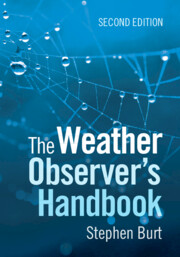Book contents
- The Weather Observer’s Handbook
- Reviews
- The Weather Observer’s Handbook
- Copyright page
- Dedication
- Epigraph
- Contents
- Foreword
- Acknowledgements
- Author’s note
- Abbreviations, footnotes and references
- Part I The basics
- Part II Measuring the weather
- 4 Site and exposure: The basics
- 5 Measuring the temperature of the air
- 6 Measuring precipitation
- 7 Measuring atmospheric pressure
- 8 Measuring humidity
- 9 Measuring wind speed and direction
- 10 Measuring grass and earth temperatures
- 11 Measuring sunshine and solar radiation
- 12 Observing hours and time standards
- 13 AWS data flows, display and storage
- 14 Non-instrumental weather observing
- 15 Calibration
- 16 Metadata: What is it, and why is it important?
- Part III Making the most of your observations
- Book part
- References and Further Reading
- Index
16 - Metadata: What is it, and why is it important?
from Part II - Measuring the weather
Published online by Cambridge University Press: 21 May 2024
- The Weather Observer’s Handbook
- Reviews
- The Weather Observer’s Handbook
- Copyright page
- Dedication
- Epigraph
- Contents
- Foreword
- Acknowledgements
- Author’s note
- Abbreviations, footnotes and references
- Part I The basics
- Part II Measuring the weather
- 4 Site and exposure: The basics
- 5 Measuring the temperature of the air
- 6 Measuring precipitation
- 7 Measuring atmospheric pressure
- 8 Measuring humidity
- 9 Measuring wind speed and direction
- 10 Measuring grass and earth temperatures
- 11 Measuring sunshine and solar radiation
- 12 Observing hours and time standards
- 13 AWS data flows, display and storage
- 14 Non-instrumental weather observing
- 15 Calibration
- 16 Metadata: What is it, and why is it important?
- Part III Making the most of your observations
- Book part
- References and Further Reading
- Index
Summary
Metadata is literally ‘data about data’. In the context of meteorological records, metadata covers the description of the observation site and its surroundings, the instruments in use and their units together with any significant changes over time, and any other relevant information, such as where the site’s records are archived. Its importance lies in providing essential information for any other user of the records to understand more about the location and characteristics of the data, and therefore enables more informed use of the data. Metadata are especially important for elements which are particularly sensitive to exposure, such as precipitation, wind and temperature, and for professional sites, especially so for long-period records. This chapter sets out what should be recorded, following guidelines laid down by the World Meteorological Organization in the so-called CIMO guide (Commission for Instruments and Methods of Observation).
Keywords
Information
- Type
- Chapter
- Information
- The Weather Observer's Handbook , pp. 351 - 360Publisher: Cambridge University PressPrint publication year: 2024
